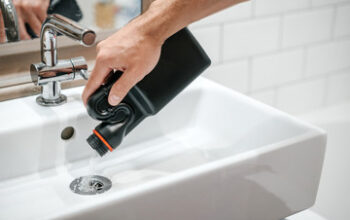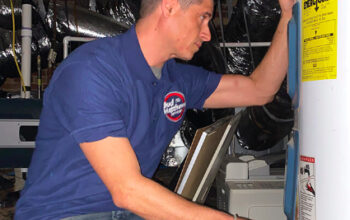Platinum Plumbing career involves various tasks, from designing and installing water systems to conveying fluids. The various tools of the trade include pipes, valves, tanks, and other apparatuses. You may also be interested in learning about PEX and cross-linked plastic pipes. Below are some of the most common plumbing jobs, including the types of pipes and valves you’ll need to use. Listed below are the benefits of each type of pipe.
Copper
 A recent study revealed that copper pipes exhibit antimicrobial properties. In a study using drinking water, copper pipes delayed the formation of biofilms. While microbial and virus counts were not statistically different, copper pipes were significantly less susceptible to biofilms. Biofilms are known to cause blue water events and pitting corrosion. Copper pipes are a good choice in these situations because they offer protection from bacteria. However, these pipes must be properly cleaned.
A recent study revealed that copper pipes exhibit antimicrobial properties. In a study using drinking water, copper pipes delayed the formation of biofilms. While microbial and virus counts were not statistically different, copper pipes were significantly less susceptible to biofilms. Biofilms are known to cause blue water events and pitting corrosion. Copper pipes are a good choice in these situations because they offer protection from bacteria. However, these pipes must be properly cleaned.
Generally, the higher the alkalinity, the greater the copper corrosion release. This is likely due to the formation of soluble Cu(II) bicarbonate and carbonate complexes in plumbing systems. Copper corrosion releases occur at higher alkalinity levels, and insufficient pH and alkalinity levels can form an insoluble malachite scale. This study found that copper levels in pipes were greater than one mg/L in water that was not softened.
The second type of plumbing pipe is made from copper. This material is more resistant to corrosion than other materials. Copper can withstand up to 1,000 psi of pressure, and it is easier to bend than iron. In contrast, iron pipes may split under severe conditions. However, it’s important to note that copper pipes are lightweight and can last as long as 50 years without requiring repair. Copper is also less prone to rust and corrosion than other materials.
Plastic
If you’re looking for an environmentally-friendly material for your plumbing system, you should consider the advantages of using plastic for plumbing. There are several types of plastic available, including the environmentally-friendly PVC, which is heat-welded and UV-resistant. However, before you make a choice between these two options, it is important to know what they are. Read on to discover the advantages and disadvantages of each one. Listed below are some of the benefits of these materials.
One advantage of using plastic is that it is easier to install. This means that you can save money and time in the long run. Installing plastic pipes and fittings can be a simple, easy-to-install process. This type of material has become more popular in recent years and has far fewer environmental effects. Using plastic has many advantages over metal, so it makes sense to consider your options.
Plastic cross-linked
The market for Plastic cross-linked plumbing is estimated to exceed USD 1 billion in 2017. Increasing use in consumer goods, packaging, and insulation sectors are expected to fuel the market for this product. Plastic pipes are low-cost, easy to install, and highly flexible. The following are key trends in the market. These trends are expected to continue into the future. Listed below are some of the leading companies involved in this market. Further, you can read more about the company’s products and services.
PEX, or polyethylene cross-linked, is a newer engineered plastic that was first introduced in the mid-1980s for use in radiant heat systems. PEX is used for plumbing but also has several other applications. It is an excellent alternative to PVC, copper tubing, and polyvinyl chloride (PVC).
PEX
While there are many benefits to using PEX for plumbing, it is a relatively new technology. PEX pipes have high heat resistance, which makes them easier to bend and install than rigid pipes. They are also more durable, reducing the risk of rupture due to freezing. This article will explore some of the benefits of PEX pipe. The following are some reasons to use PEX for plumbing. Once you’ve heard about these benefits, you’ll be ready to switch to PEX for plumbing in your home.
PEX is a versatile material that does not require soldering. It is also resistant to corrosion, unlike copper and galvanized steel pipes. Because it is resistant to corrosion, PEX pipes can last for decades without experiencing leaks or contamination of your water supply. PEX also eliminates the hammering noise associated with metal pipes. PEX is also compatible with existing metal supply lines and fixtures. But do your research before choosing PEX for plumbing!
DWV
A DWV for plumbing is a system that allows air to enter the system. Depending on air pressure, the sewage and greywater can be removed. Wastewater is water from toilets, while the drain is water produced at fixtures. A DWV is a must-have for any plumbing system. It can save you time and money in the long run. Here are some advantages of a DWV. Weigh the pros and cons of a DWV before you buy one.
The benefits of DWV piping are many. PVC is a common choice for basement applications where moisture is high. Galvanized steel is used for waste lines and can handle pressure from several floors above. ABS piping meets building codes across most jurisdictions. There are a variety of materials available for DWV piping. Some are suitable for both non-pressure and pressure applications. When selecting a system for your project, make sure to review your local codes before you make your decision.
Bypass valves
Bypass valves in plumbing divert water around treatment devices. If your system breaks down, you can divert water around it while repairing it. Bypass valves are especially useful for city water owners who don’t have the time or money to replace their whole-house dechlorinating filter. Similarly, if your dechlorinating water filter is malfunctioning, you can divert irrigation water around it, which will provide you with clean water while the system is repaired.
To replace a bypass valve, you can purchase a replacement part. You can find these in home plumbing stores, online, or in your local hardware store. Bypass valves are made of stainless steel and are resistant to hard water. The good thing is that they are easy to clean; simply soak them in vinegar to remove mineral deposits. Bypass valves are essential for your home plumbing system, and you can replace them easily if you choose to.
For first-timers, bypass valves may be difficult to turn. If the bypass valve is not on the same side as the softening unit, you need to press the button firmly until it fully presses in. If you’re having trouble getting the lever in the desired position, use a rubber mallet instead of a regular hammer. To bypass a water softening unit, make sure that the bypass valve is close to the softening unit.
PEX pipes
While traditional copper, cast iron, or galvanized steel pipes require the smaller pieces to be soldered into the main water supply, using PEX pipes means that minor adjustments can be made to the main line without causing any damage. PEX pipes are flexible and can even pass through walls. And because they are made from plastic, they do not need to be glued together like traditional pipes. And they are less expensive than traditional plumbing materials.
PEX piping also makes it easy to separate hot and cold lines. There are two types of PEX piping – type A and type B. Type A is a more flexible plastic, whereas type B has a stronger coil memory. It resists cracking when it expands or contracts, and it also allows for easier access to extra tubing if needed. PEX piping for plumbing has become increasingly common in homes due to its durability.
Copper pipes
When repairing copper pipes, it is best to use lead-free tap solder. Lead-acid solder is used for non-drinking water applications. Use a lead-free solder paste on at least one inch of the pipe before attempting to repair it. When soldering copper plumbing pipes, you must apply a thin layer of flux to the copper pieces before applying solder. The copper pieces should fit snugly into the pipe and be twisted to distribute the flux.
Another benefit to copper pipes in plumbing is that they are impervious to outside chemicals. This means that the water is protected from the effects of petroleum products spilled on the street. The same is true of fertilizers and insecticides applied to the yard. These chemicals can weaken a plastic service line and contaminate the water within an hour. While these conditions are rare, they do happen. Copper pipes are designed to withstand natural stresses and ruptures, unlike synthetic plastics.
Unlike plastic pipes, copper is much lighter and easier to transport. As a result, it is preferred over galvanized steel and plastic pipes. Copper pipes come in several different types, including types K, I, and m. You may also encounter DWV copper piping in old residential buildings. As with any material, it is important to source your copper plumbing materials from a reputable source. Copper is more expensive than PEX, but it is also more durable and resistant to corrosion. The downside is that copper pipes are susceptible to cracking when exposed to freezing temperatures.


